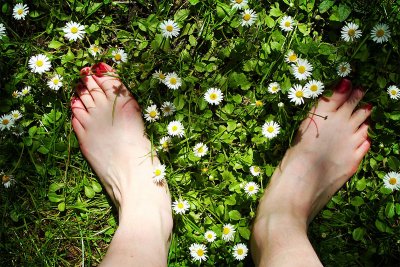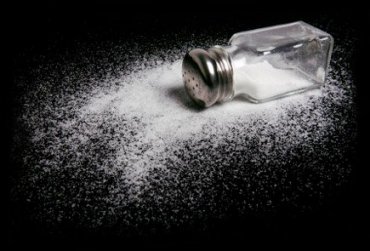Mood:
Topic: Alternative Health

By Dr. Mercola
Dr. James Oschman is an expert in the field of energy medicine, with a Bachelor's Degree in Biophysics and a PhD in Biology from the University of Pittsburgh.
As an author of a number of books, he is widely recognized as an authority in the biophysics of energy medicine. In this interview he discusses the practice of "earthing," or grounding.
Every modern school of alternative medicine talks about "energy," although they may use a variety of words to describe it. But what is this fundamental "energy" you keep hearing about?
As Dr. Oschman went about to investigate, he found there is very good science that can help demystify this nebulous term. He wrote a number of articles for a journal published by Churchill Livingstone on the subject, and after some encouragement from the publisher, those articles eventually resulted in two books: Energy Medicine: The Scientific Basisi, and Energy Medicine in Therapeutics and Human Performanceii.
Dr. Oschman was also introduced to earthing, or grounding, and his research in this area has turned up some very interesting and compelling information about how the energy from the Earth can help you live a healthier life. He has recently written the Foreword for a new book by Clinton Ober, Dr. Stephen T. Sinatra and M. Zucker, entitled Earthing: the most important health discovery ever?iii published in 2010 (Basic Health Publications, Inc., Laguna Beach, CA.).
If you're like most people, you probably wear shoes with rubber or plastic soles for the better part of each day. Read on to learn why shoes might be one of the banes of modern existence.
The Emergence of "Earthing"
The concept of earthing, also known as grounding, was initially developed by Clint Ober. Stated in the simplest terms possible, earthing is simply walking barefoot; grounding your body to the Earth. Oschman was introduced to Ober via Jeff Spencer, the chiropractor for Lance Armstrong's cycling team and an expert in treating professional athletes.
"When Clint described the earthing phenomenon to Jeff, Jeff immediately called me and had me fly out to California to meet Clint and talk about what kind of research could be done to find out what is going on," Oschman explains.
"People have known for a long time that walking barefoot feels good. There are places in the world like Germany and Austria and Switzerland with communities where there is a tradition of getting up in the morning and going barefoot."
My own introduction to the concept of earthing was also through Jeff Spencer, some five or six years ago. I found it very intriguing, although I initially approached it with some skepticism. As you will soon see, it's a simple concept—to some it may appear too simple.
Fortunately, Dr. Oschman is now able to provide the scientific groundwork for understanding what actually occurs. In fact, his team has now published about a dozen papers on this topic.
What Happens to You When You Walk Barefoot?
Your skin in general is a very good conductor. You can connect any part of your skin to the Earth, but if you compare various parts there is one that is especially potent, and that's right in the middle of the ball of your foot; a point known to acupuncturists as Kidney 1 (K1). It's a well-known point that conductively connects to all of the acupuncture meridians and essentially connects to every nook and cranny of your body. Interestingly, grounding—or rather the lack thereof—has a lot to do with the rise of modern diseases.
How is this?
Well, Dr. Oschman's research into grounding has led him to better understand inflammation. I've discussed before, chronic inflammation is a primary cause of virtually all disease, from diabetes to cancer. And by looking at what happens during grounding, the answer to why chronic inflammation is so prevalent, and what is needed to prevent it, is becoming better understood.
When you're grounded there's a transfer of free electrons from the Earth into your body. And these free electrons are probably the most potent antioxidants known to man.
These antioxidants are responsible for the clinical observations from grounding experiments, such as:
Beneficial changes in heart rate
Decreased skin resistance
Decreased levels of inflammation
To better understand the science behind what happens during grounding and how it impacts the inflammatory response, Dr. Oschman begins by explaining what happens when you experience an injury.
"Even the slightest bump, if you bump the door, your immune system immediately responds by sending white blood cells (neutrophils) to the place of injury…
The neutrophils secrete a Reactive Oxygen Species (ROS)… called free radicals, in what's referred to as an oxidative burst... These are like Pac-Man. They are very important molecules that tear things apart. If bacteria have gotten through your skin, these free radicals will destroy the bacteria very quickly. If you have damaged cells, the free radicals will break them apart so that there is a space for healthy cells to move in and repair the tissues.
That's known as the inflammatory response.
What we have discovered that is truly profound is this: we now understand why you get the inflammatory response, which has five characteristics: pain, redness, heat, loss of range of motion, and swelling. All of those are the five hallmarks of inflammation and it turns out that that doesn't have to happen.
Inflammation, which in medicine is considered an important part of the healing process, is really an artifact caused by lack of electrons in your tissues. What happens is, the neutrophils deliver the Reactive Oxygen Species (ROS) to the site of injury, but in so doing, some of those free radicals can leak into the surrounding tissue and damage healthy tissue. That's what creates the inflammatory response".
Interestingly, grounding research has now discovered that if you place your feet on the ground after an injury (or on a grounded sheet, or place grounding patches on the balls of your feet), electrons will migrate into your body and spread through your tissues. Any free radicals that leak into the healthy tissue will immediately be electrically neutralized. This occurs because the electrons are negative, while the free radicals are positive, so they cancel each other out.
"So really what is happening with grounding or earthing is that you're protecting your body from -- I call it, collateral damage," Dr. Oschman says. "Damage that was not intended to take place but does take place because we have disconnected ourselves from the Earth by putting rubber and plastic on the bottoms of our shoes."
Earthing as an Anti-Aging Strategy
One of dominant theories on aging is the free radical theory, which is that aging occurs because of accumulative damage to your body caused by free radicals. You get free radicals when you have an injury or chronic inflammation, from breathing, and from the food you eat, among other things. While you don't want to completely eliminate ALL free radicals, you do want to maintain a healthy balance of antioxidant electrons in your body to ensure the damage from free radicals doesn't' get out of hand.
Earthing can help accomplish this delicate balance.
There are three kinds of sub-models of the aging process caused by free radicals.
1. DNA damage and mutation due to free radical damage
2.The mitochondrial theory. Mitochondria in every cell in your body carry out oxidative metabolism and a byproduct is free radicals. Eventually the mitochondria wear out or self-destruct due to excess free radicals
3.The protein cross linking theory, which explains why you get wrinkles in your skin. The proteins stick to each other, reducing the efficiency of enzymes
"It looks to me, from my study of biophysics and cell biology, like the body is designed with a semi-conductive fabric that connects everything in the body, including inside of every cell," Dr. Oschman says.
"I refer to this system as the living matrix. Those electrons that enter the bottom of your foot can move anywhere in your body. Any place where a free radical forms, there are electrons nearby that can neutralize that free radical and prevent any of those processes: mitochondrial damage, cross linking of proteins, and mutation or genetic damage.
So the whole fabric is basically an antioxidant defense system that is in every part of our body.
We have this material called ground substance which is part of the connective tissue. It goes everywhere in the body. It's a gel material and it stores electrons. So that if you go barefoot, you will take in electrons and your body will store them, and they will be available at any point where you might have an injury, or any point where a free radical might form..."
How Grounding Affects Your Blood
Another very important discovery, and one of the most recent, is that grounding thins your blood, making it less viscous. This discovery can have a profound impact on cardiovascular disease, which is now the number one killer in the world. Virtually every aspect of cardiovascular disease has been correlated with elevated blood viscosity. Dr. Sinatra has been coaching Dr. Oschman's team in how to measure blood viscosity using a method called zeta potential. It measures the potential on your red blood cells by determining how fast they migrate in an electrical field.
It turns out that when you ground to the earth, your zeta potential quickly rises, which means your red blood cells have more charge on their surface, which forces them apart from each other. This action causes your blood to thin and flow easier. It also causes your blood pressure to drop.
Another obvious implication of this is that by repelling each other, your red blood cells are less inclined to stick together and form a clot. Blood clots don't have to be very big to form like a pulmonary embolus that would kill you instantly, so this is a significant benefit. Additionally, if your zeta potential is high, which grounding can facilitate, you not only decrease your heart disease risk but also your risk of multi-infarct dementias, where you start losing brain tissue due to micro-clotting in your brain.
The Best Surfaces for Grounding
Clearly, the simplest way to ground is to walk barefoot outside when safe to do so. But what about urban or city dwellers who are surrounded by asphalt and concrete? Can you ground on those? And what about natural surfaces—which ones are the most effective? There are indeed significant differences between various surfaces.
The ideal location for walking barefoot is the beach, close to or in the water, as sea water is a great conductor. Your body also contains mostly water, so it creates a good connection.
A close second would be a grassy area, especially if it's covered with dew, which is what you'd find if you walk early in the morning. According to Dr. Oschman, concrete is a good conductor as long as it hasn't been sealed. Painted concrete does not allow electrons to pass through very well. Materials like asphalt, wood, and typical insulators like plastic or the soles of your shoes, will not allow electrons to pass through and are not suitable for barefoot grounding.
Why Living in a High-Rise Could be Detrimental to Your Health
Additionally, there's a major difference between standing outside in your bare feet and standing outside in shoes. And, how high up you are, off the surface of the Earth, without being grounded also matters. Why is this?
Dr. Oschman explains:
"The Earth's surface is electrically charged and can push electrons up in your body. So from the top of your head to the Earth, there is a potential, which you don't feel because it doesn't cause any any particular current to flow, even though it can be a couple of hundred volts. If it did, it would give you a shock.
What happens is when the weather changes is that the potential can go up enormously. It can go from a hundred volts per meter to 10,000 volts per meter. That's pre lightning. We're talking about the potential that causes lightning to come to the earth. That voltage is well known and well understood…
This is the potential between the surface of the earth and the ionosphere, hundreds of miles up, which is very electrically active; charged by the solar wind, the charged particles that come from the sun. Those charged particles eventually reach the Earth by lightning and electrify the entire surface of the Earth so that anywhere you touch the Earth, there are electrons. They come originally from the sun, to the ionosphere, to the earth.
There is no lightning happening right here right now but somewhere there is lightning, a constant current flow from the ionosphere to the earth. Those are the electrons that your body needs for your immune system to function properly."
What this means is that the higher up you are, separated from the surface of the Earth, the higher this potential would be, and the worse the implications for your health if you're not grounded. For example, if you live on the 20th floor of a high-rise and you're not grounded (using grounding technology, of course), the consequences to your health will be more significant than if you lived on the first floor. Likewise, when you wear rubber- or plastic-soled shoes, you are effectively shielding yourself from this beneficial influx of electrons from the Earth. For optimal immune function, you want these electrons to enter your body, so make sure you take your shoes off now and then!
Easy Ways to Incorporate Grounding Into Your Daily Life
Exercising barefoot outdoors is one of the most wonderful, inexpensive and powerful ways of incorporating earthing into your daily life and will also help speed up tissue repair and ease muscle pain due to strenuous exercise.
Dr. Mercola is the founder of the world’s most visited natural health web site, Mercola.com. You can learn the hazardous side effects of OTC Remedies by getting a FREE copy of his latest special report The Dangers of Over the Counter Remedies by going to his Report Page.








